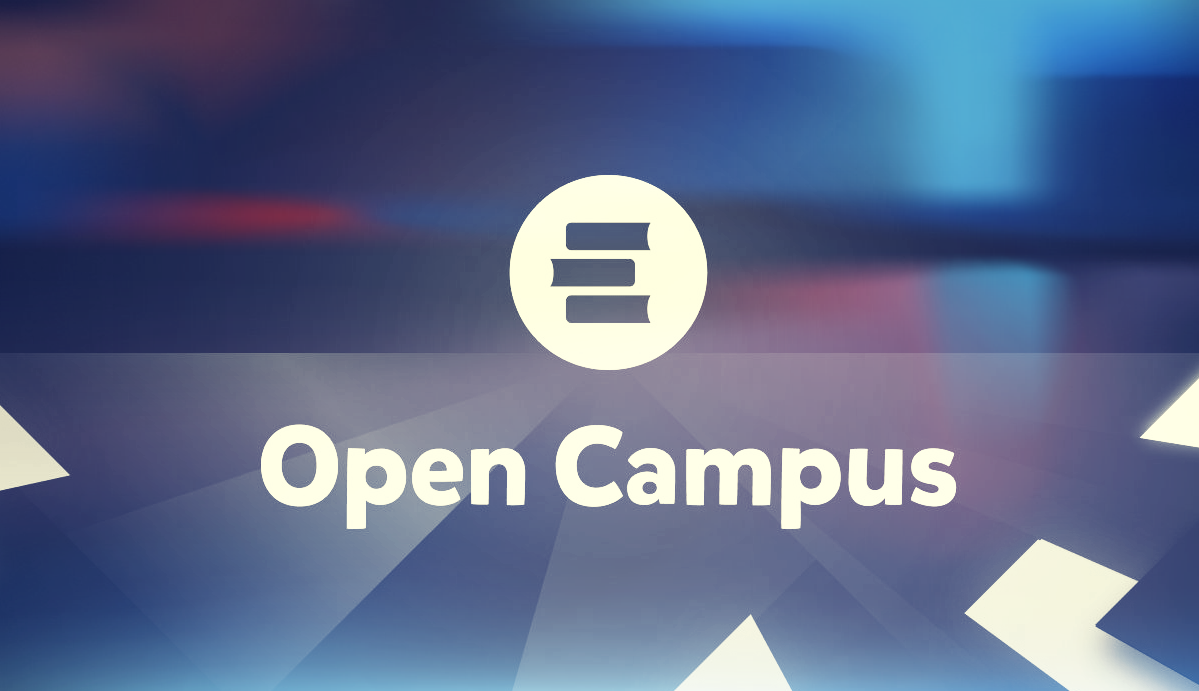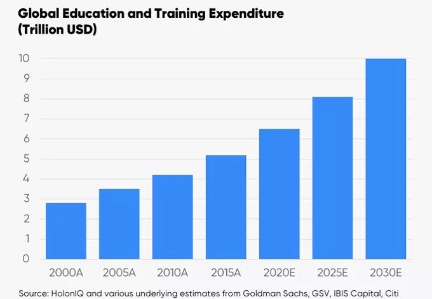教育EduFi成为加密新叙事,Open Campus开辟Web3教育新时代

“ 1、教育;2、合规;3、产品和服务;4、忽略 FUD、虚假新闻和攻击等。”今年年初,Binance 创始人兼 CEO CZ 在 Twitter 发文称, 2023 年将重点关注四件事。教育排在第一位,足以见得在其心中的分量。
此后,CZ 又在不同的场合、AMA 中多次论述 Web3 教育的重要性,“Binance 在教育领域还是做的不够好,所以教育是 Binance 应该关注的事情”。除了口头上的重视,Binance 也身体力行的推动 Web3 教育,并上线了 Web3 教育赛道龙头项目 Open Campus。
作为一个社区主导的 Web3 教育协议,Open Campus 希望通过区块链技术的力量来创建一个更加公平的教育体系,将控制权交还给教育者和学习者:通过代币化教育内容,促进更多优质教育内容的生产,增加教育创造者收入,同时也让学习者能够访问更多样化的教育内容。Open Campus 在 Web3 教育领域的创新和前瞻性,将为市场规模高达 5 万亿美元全球教育市场带来革命性的变革。
对加密市场而言,Open Campus 将圈外优质教育资产代币化也为行业引入增量,在此基础上创造了一种全新的模式 EduFi(Education+DeFi),也为熊市打开新的叙事。
随着 Web3 技术及其应用场景的不断发展,EduFi 的概念将会得到更多的认可和应用,Open Campus 也将在其中扮演越来越重要的角色。
一、Web3教育成 2023 年最重要新趋势
从前两年的 GameFi、NFT、二层网络(Layer 2),到今年的比特币铭文、BRC 20 以及真实资产(RWA)等等,一个个细分赛道陆续成为市场焦点,也为早期参与者带来阿尔法收益(超额收益)。如今热度退却,市场正在迫切找寻下一个增长点。
具有行业基础性、先导性、全局性地位的 Web3 教育由于发展时间尚短,竞争并不激烈,吸引了包括币安在内的越来越多机构和个人关注。Web3 教育是一个新兴的领域,具有很高的发展潜力和机会,将成为 2023 年加密市场最重要的趋势之一。
从发展前景来看,对照传统教育市场规模,Web3 教育还有很强的成长空间。根据世界银行数据, 2020 年全球教育行业的市场规模已超过 5 万亿美元,中国等国家的教育投资额也在逐年增加;随着科技的不断创新和应用,传统教育市场规模还将继续扩大,预计到 2030 年将达到 10 万美元。

尽管传统教育市场规模不断扩大,但也存在着许多问题和挑战,教育成本高、教育质量不均衡、教育资源匮乏、教育管理滞后等。
传统教育机构的运营成本和学费较高,对于一些经济条件较差的学生而言,难以承受这一费用;对贫困地区而言,教育基础设施不完善影响学生接受教育的机会。而对教育创作者来说,没有获得应得的收入,收入与付出不成正比。再者,传统教育机构的课程体系和学习资源都比较固化和封闭,在满足学生基本需求的同时,缺乏灵活性和创新性,不能够满足不同学生的个性化需求。另外,当前社会发展环境快速变化,教育机构无法及时更新和调整教学内容和方法,难以保持与时俱进,适应社会变革和发展,并且教育机构之间的教学水平和教学质量存在差异,学生的教育获益也会因此存在不确定性。
传统教育体系对学习者、教育创作者都造成了束缚,教育不公的现象较为普遍。在传统教育模式的基础上,引入区块链这样的新技术或许可以有效弥补传统教育短板,适应现代社会对于教育的新需求。
Open Campus 正是一个结合教育创作与区块链技术的平台。该平台允许教育工作者创建和分享自己的创新教材,学生可以根据自己的需求来选择相应的教材学习,社区可以创建、拥有和推广他们想在世界范围内了解的内容。特别是对教育工作者来说,代币化技术可以帮助他们将传统教育课程变成链上资产,供学生自由选择,减少中间商赚差价,有效提高教育创作者的收入,并获得学习者和平台对他们贡献的认可。
Open Campus 的出现,对于优化传统教育模式、满足现代社会教育需求具有重要意义。因此,Open Campus 被各方寄予厚望,Binance 也将其作为第 31 个 Launchpad 项目以及Web3 教育赛道的标杆进行主推。
二、Open Campus:教育资源代币化,实现教育公平
“出版商 NFT(Publisher NFT)在 5 个月内为我赚了 9, 767 美元,用户为教育内容支付了真金白银。不再有中间商成本,教师/创作者现在直接收获价值。”一名叫「Misa Matsuzaki」的内容创作者,在 Twitter 上分享了自己使用 Open Campus 的直观感受。

Misa Matsuzaki 的经历并非孤例,而是 Open Campus 千千万万教育创作者的缩影,而他们的诚挚感谢也是 Open Campus 的初心所在:通过代币化教育内容,让教育者的贡献和付出“被看见”和“被认可”,得到可观的回报,反过来促进更多优质教育内容的产生。
Open Campus 搭建了一个完善的协议层基础设施,供学校、科技教育平台和其他教育者使用,让他们将产出的教育内容带给全球的学生,教育内容及课程可以代币化为 NFT,内容产生的收入将经由智能合约分发给创作者、NFT 的持有人及其他贡献者。该平台用户分为三类:
社区(学习者),可以创建、拥有和推广他们想在世界范围内了解的教育内容,并且利用区块链技术为符合其需求的教育内容提供资金、共同拥有和收益;
创作者,通过出版商 NFT(Publisher NFT)提供促销权,根据协议推出他们的内容,联合出版商可以根据他们的贡献获得收入,其中创作者和营销者共享出版权;
慈善家,可以直接通过捐赠来支持此类教育事业,并且可以通过链上数据追踪他们的捐赠资产。
举个例子,小秦现在看到 AI 火爆,作为一名 AI 技术大咖他想要进行知识变现。受限于自己的人脉以及知名度,市场上的知识付费平台也没有对其进行流量推荐,小秦几个月来处于无人问津的状态。
此时,小秦可以在 Open Campus 注册成为内容创作者,而后将自己的 AI 技术教程通过 Open Campus 平台生成教育内容并进行提交。经过专业审核通过后(注:主要是为了防止垃圾信息污染平台)小秦需要使用平台代币 EDU 支付费用,将其内容铸造成一个 Publisher NFT,并在市场中出售该 NFT。
NFT 进入市场后,学习者小王觉得非常有趣,遂使用 EDU 代币购买了该课程,小秦也通过出售该 NFT 获得了收入。小王在学习完成后,会获得平台课程认证,
当然,到此并没有结束。平台上的「联合发行商」觉得小秦的 AI 内容质量较高,于是买下该 NFT 自费进行推广,该 NFT 被更多的学习者了解并进行购买,此时小秦作为原始内容创作者可以继续获得二次版税收入——只不过需要将收入抽取一定比例的给予联合发行商和合作伙伴平台。
总结一下,Open Campus 最大的亮点就是将传统的教育模式与区块链技术相结合,创造出基于 NFT 的教育内容市场。通过这种方式,Open Campus 不仅可以保障教育内容的版权和流通性,也能够满足用户对高质量教育资源的需求。
第一个采用 Open Campus 协议的公司是 TinyTap,它也是全球教育行业的佼佼者,也是 App Store 及 Google Play 上是头十名总收入最高的儿童移动应用程式。目前,TinyTap 平台已有超过 25 万互动课程,有超过 9 百万家庭使用过并有超过 10 万名创作者,并与芝麻街、牛津大学等多个著名的出版商合作。并且,TinyTap 也是 BNB Chain 上的明星项目——以活跃钱包数排名,TinyTap 位列 BNB Chain 最活跃 dApp 前五名。
去年 11 月,TinyTap 的第一批 Publisher NFT 出售获得收入 138.926 ETH(约 228, 000 美元), 12 名教师(创作者)获得了收入的一半;销量最高的 NFT 为其创作者带来 37, 600 美元收入,是以色列公立教育系统小学教师平均月薪的 13.4 倍。
此外,今年 5 月 Open Campus 宣布推出价值 1000 万美元的全球教育工作者基金,旨在奖励全球的教师和创作者,为 Open Campus 及其合作伙伴平台开发 K-12 教育内容。申请者可以是合格的教师、教育机构以及具有主题知识的个人或团队。
通过引入区块链技术,Open Campus 为教育者、学习者、出版商和共同出版商创造一个更公平且更具包容性的生态系统,在为他们提供更多 Web3专 业知识获取途径的同时,保障教育内容的所有权,促进生态系统的持续增长和发展。在这个蓬勃发展的环境中,创新、创造力和知识共享得到弘扬和培育,为教育创造更加光明的未来,也将全球数十亿教育工作者和学习者带入 Web3 的世界。
三、 引入增量,EduFi 拓展的新的 DeFi 业态
在 4 月上线 Binance 后,Open Campus 原生代币 EDU 价格最高上涨至 1.69 USDT,较 IEO 发行价 0.05 USDT 最高涨幅约 3300% ;目前 EDU 价格约为 0.74 USDT,仍然有近 14 倍的涨幅。实际上,在整个 Open Campus 生态中,EDU 起到了关键的支撑作用,用例包括:
治理: EDU 持有者可以提交协议的 DAO 提案并对其进行投票(例如,参与规划分配给生态系统的 Token 使用量等)。
付款: EDU 可以作为采用 Open Campus 协议提供的产品和服务的付款方式(例如 TinyTap,其中一定百分比的收益将分配给 Open Campus Protocol)。
链上收益分享:贡献者(包括内容创建者、发布者、平台)在 EDU 中获得协议收益的份额。
用户获取: EDU 可用于激励和引导 Web2 用户加入 Web3,因为他们可以在访问协议生态系统合作伙伴(例如 TinyTap)提供的产品时获得折扣。
内容所有权:用户可以通过出版商 NFT 与 EDU 购买共同出版权。
问题来了,EDU 会是一个好的投资标的吗?
从发展前景来看,EDU 作为生态支付代币,增值与 Open Campus 商业版图扩展密不可分。实际上,除了 TinyTap,Open Campus 还与多家顶级教育公司达成合作,将这些教育内容搬到链上,形成了一个庞大的教育内容池。
例如私立学校网络之一的 GEMS 教育,其在北非和中东地区拥有 60 多所学校和超过 130, 000 名学生,其他许多合作伙伴包括但不限于 Animoca Brands、Sandbox 等。由于只有使用 EDU 代币才能铸造这些 Publisher NFT,且售卖也必须使用 EDU 进行支付,所以 EDU 代币成为了这个生态系统中不可或缺的一部分。
仅以 TinyTap 为例,上一次 Publisher NFT 拍卖获得收入约是正常收入的 5 倍,该公司年收入收入接近一千万美元,在与 Open Campus 合作将教育资源代币化后,Publisher NFT 的收入可能有机会增长至 5000 万美元,而这些 NFT 的拍卖也会对 EDU 形成上千万美元的买盘,价值数千万美元的 EDU 代币最终回到项目国库。此后,随着这些顶尖教育公司入场,对于 EDU 的购买量以及消耗量也将随之变得更大。
更关键的是,这些优质教育资产通过代币化进入加密生态,具备了可流通性和交易性,也可以衍生出更多的新的玩法。例如,教育资产所生成的 Publisher NFT,可以在链上进行质押;如果是稀缺资源还可以进行碎片化,分解成更多的 Token 进行交易。优质的教育资产,也将为加密市场带来新一轮增量资金。凡此种种,进一步为 DeFi 生态提供了新的思路和机会,因此可以将其称为「EduFi」(Education+DeFi)
当然,市场普遍对于新生项目的抛压感到担忧,特别是目前价格涨幅较高,早期投资者可能获利出逃或者项目方砸盘套现。今年五月底,大量 EDU 被转移到一个新的钱包地址,引发社区恐慌。随后 Open Campus 官方曾发布公告称,转移代币时出现错误,没有代币被出售,并将代币已经返回到初始钱包,而后根据每月 28 日的释放时间表进行解锁。
根据 token.unlocks 数据,目前 EDU 流通量约为 1.87 亿枚,流通市值为 1.3 亿美元。但实际上,其真实流通盘大约只有 1.1 亿枚,根本原因在于大部分已解锁的代币还留存在钱包里并没有流出市场。7 月 4 日,Open Campus 发推称,鉴于宏观波动和市场环境,早期贡献者、流动性提供者和生态代币解锁时间延期 3 个月,其他代币释放时间不变。因此,EDU 真实流通市值大概只有 8000 万美元,仅 TinyTap 一家公司的收入就可以推动 EDU 获得不错的涨幅。
作为一个社区驱动的链上协议平台,Open Campus 在引入合作伙伴上相比于中心化平台也会有独特优势,更加清晰、透明的收益分配,将使得更多的合作伙伴愿意加入这一网络,壮大用户群体,让教育者的贡献能够享受更多的网络效益,而得益于激励机制,教育内容的供给和质量也会提升,最终创造可持续的经济模型,实现长期主义双赢。不论是从 Token 经济还是从实际应用层面,Open Campus 都是一个非常优质的 Web3 教育项目。
写在最后
如今加密市场进入熊市,市场整体交易热情不高,优质教育资产的进入可以有效激发市场的内在动力,特别是 EduFi 的概念有望激发并引领新一轮浪潮。随着 Web3 教育的发展,EduFi 的概念将会得到更多的认可和应用,Open Campus 也将在其中扮演越来越重要的角色。
对 Open Campus 而言,在塑造了新教育范式,确保教育内容被共享的同时,保留了作品的所有权,并且帮助增加教育工作者创收途径,为他们持续输出优质内容提供动力。
总的来说,Web3 教育能够突破传统教育地域边界的限制,打开新的流量入口,推动教育的无边界发展,真正意义上实现了教育公平,让每个人都有平等的受教育机会。



